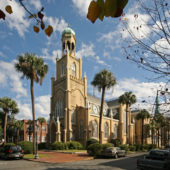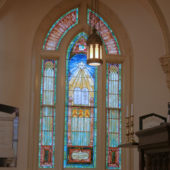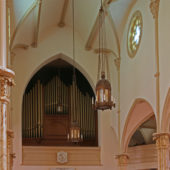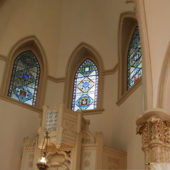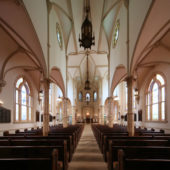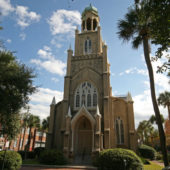Purposely built to resemble a Gothic church, Congregation Mickve Israel is the oldest synagogue in the United States where Reformed Judaism is now practiced.
On July 11, 1733, forty one Jewish pioneers seeking to escape the Spanish Inquisition arrived in Savannah, Georgia from London, England. They comprised 33 Portuguese Jews and 8 German Jews. As there were more than enough men to form a minyan (prayer service of at least 10 men), worship began immediately with the Torah (first five books of the Bible) scroll they had brought with them from London. Meeting in members’ homes, by July of 1735, the congregation Kahal Kodesh Mickva Israel (Holy Congregation Hope of Israel), or “Mickva Israel” for short, was begun. “Mickva Israel” is a phrase from Jeremiah 17:13, a scripture encouraging Israel to remain steadfast in its Messianic hope. (In 1648, the famous Amsterdam Rabbi Manashe wrote a book based on this scripture and many synagogues subsequently sprung up with similar names.)
The Congregation Mickve Israel obtained a charter from the State of Georgia in 1790, establishing it as the United States’ third oldest Jewish congregation. At the time that these brave pioneers left London for The New World, there were approximately 6,000 Jews living in London. Many of the London Jews were affluent and supported the new congregation in Savannah, Georgia monetarily.
In its early years the congregation, met at a house on Market Square, which had been renovated to suit its needs. The initial congregation was mostly comprised of Sephardic Jews. When there came an influx of Ashkenazic Jews tensions ensued. On July 5, 1742, during the war between Spain and England, thousands of Spanish soldiers landed near Savannah and planned to attack. Most Sephardic Jews fled as they were being accused of apostacy. Subsequently, the substantially reduced Congregation Mickve Israel returned to being held at members’ homes.
Eventually Jews began returning to Savannah and the congregation’s numbers again increased. In 1786 the Synagogue’s services were held in a rented house on Broughton Lane. After George Washington was elected President, the congregation sent him a congratulatory letter. He replied to the congregation by return letter, stating, “May the same wonder-working Diety, who long since delivered the Hebrews from their Egyptian oppressors, planted them in the promised land, whose providential agency has lately been conspicuous in establishing these United States as an independent nation, still continue to water them with the dews of Heaven, and make the inhabitants of every denomination partake in the temporal and eternal blessings of that people, whose God is Jehova.”
By 1818 the congregation had grown significantly. The City of Savannah gave the Congregation a lot and further buildings were leased. Dr. Moses Sheftall and Dr. Jacob De la Motta were instrumental in organizing the construction of a Synagogue on the site. The Synagogue was consecrated on July 21, 1820. This was the first Synagogue to be constructed in the State of Georgia. However, unfortunately the Synagogue was constructed of wood and was destroyed by a fire on December 4, 1820. The Torah and Ark were saved. A new structure built of brick was constructed on the same grounds.
In 1840 there was a huge influx of German Jewish immigrants into Savannah. By 1853 the congregation could afford a rabbi. Its first full time rabbi, Reverend Jacob Rosenfeld, served from 1853 until 1862. The congregation swelled in size and in 1876 the groundwork was begun for the Monterey Square building which was consecrated on April 11, 1878. This magnificent, pure neo-Gothic edifice remains as the home of Congregation Mickve Israel today.
New York architect Henry G. Harrison was commissioned to build this imposing structure. Congregation Mickve Israel is the only Gothic Synagogue in the United States and it accurately reflects the fashionable architecture of the Victorian era. Inside, sweeping arches lined in gilded gold supported by marble-effect columns offset the pale ivory and pink ceiling. Beautiful, arched, stained glass windows are inset with the regularity and precision for which the Victorians are famous. Dark wood pews fill the Synagogue, with the Ark at the front, carved out of wood, housing the four Torah (first five books of the Bible) scrolls. Overall, the effect is of elegance, peace and splendor. The Synagogue is designed much the same as a church.
There is a three-story Sheftall Memorial Hall addition, which was opened in 2003. This houses the congregation’s museum, library, shop, religious school, offices, banquet room and full professional kitchen.
Congregation Mickve Israel is very much “alive and well” today boasting 277 anniversaries. Rabbi Robert Haas is currently the Spiritual leader of this vibrant Reform Synagogue. The congregation is involved in giving to the community, particularly with regard to its multiple programs providing for needs of elementary school children in the neighborhood. It also looks inward, not only providing to take care of the congregants’ needs, but also to host events on such varied topics as: other cultures, history, books and music.
Congregation Mickve Israel took steps toward Reformed Judaism as early as 1868 and on January 10, 1904, its transition to Reform Judaism was complete when it became a member of the Union of American Hebrew Congregations.
The Synagogue was listed on the National Register of Historic Places in 1980.

